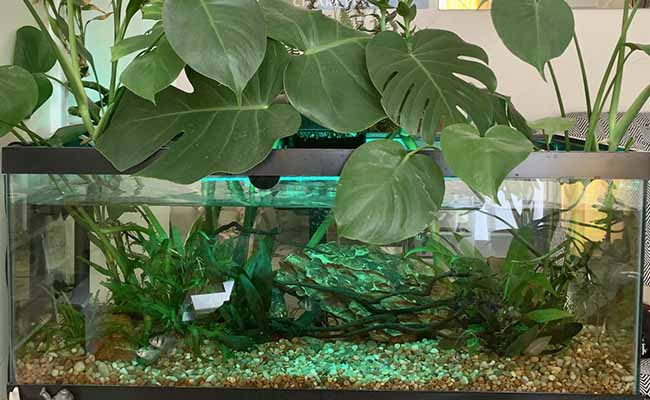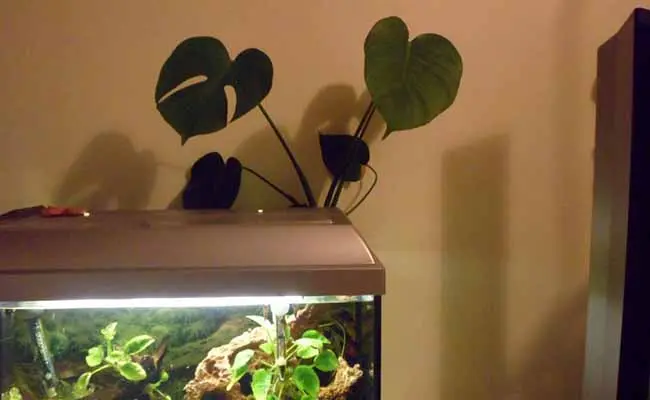Have you ever thought your aquarium could be a little more colorful? Aquatic plants for fish are another related and fascinating element that can make your fish tank very picturesque and mimic nature. But is it possible for plants that are adapted to grow on land, during a period in the show, to grow underwater? For land plants to grow in aquariums, how can they even be integrated?
Content Table
This article is going to explore the fascinating topic of land plants growing in aquariums. We will look at some of the common houseplants for aquaponics fish tanks that can be grown with their roots immersed in water, as well as the possibilities for growing on top of the tank. We will even discuss how to maintain a lid on your tank while your little plant pals grow. It’s time to turn your tank into a gorgeous aquatic paradise!

Land plants grow in the aquarium
Land Plants You Can Put in the Aquarium
Surprisingly, several terrestrial plants can be cultivated in aquariums, but with some conditions. Although they can live and grow in water, only the roots have to be immersed in water. Their leaves need to be outside the water so they can open up to breathe air and grab some sun for photosynthesis. These are some of them now popularly used.
- Pothos (Devil’s Ivy): This is a popular and easy-to-care-for houseplant that also does well in aquariums. Its trailing vines can add a nice touch to your tank.
- Philodendrons: These come in a wide variety of shapes and sizes, and many do well with their roots in water. Just be sure to choose a non-toxic variety, as some philodendrons can be harmful to fish.
- Lucky Bamboo: This is a popular choice for aquariums because it’s very low-maintenance. Lucky Bamboo can grow in water or gravel and doesn’t need any special fertilizer.
- Spider Plants: These plants are known for their cascading leaves and baby siderites. They can be placed on a ledge or platform in your aquarium, with the roots dangling in the water.
- Peace Lilies: Peace lilies can add a touch of elegance to your aquarium. They prefer low-light conditions and can help to improve water quality.
Do Live Land Plants Need Soil to Grow in a Fish Tank?
There is no need to have soil to grow land plants in an aquarium. However, unlike most of the aquatic plants that draw their nutrients from the substrate in the fish tank, these land plants can draw their nutrients directly from the water column. This is because they have adapted to intake nutrients and water in a manner that is different from those that are submerged.
Best Plants to Grow on Top of Aquariums
Pothos (Devil’s Ivy)
| One of the most well-known and low-maintenance vining plants, Pothos, prefers the humidity that an aquarium provides. It also grows trailing vines that can hang on the sides of the tank to provide a fringe of greenery and a tropical feel. Pothos is available in many colors and forms of foliage, so it is easy to select a plant that will complement the style of the aquarium. |  |
Philodendrons
| There are many genera of philodendron, and many of them have different shapes, sizes, and colors to select from. There are several types of home-planted aquariums, specifically the Heartleaf Philodendron, which has glossy, heart-shaped leaves, and the Red-Margin Philodendron, which has reddish-bordered foliage. Philodendrons are relatively low-maintenance plants and can blend the feel of a tropical rainforest into your aquarium environment. |  |
Epipremnum Aureum (Golden Pothos)
| This is another sort of pothos, and it is a fast-growing vine that is ideal for an aquarium. It has bright green and yellow leaves which are variegated, and it is easy to care for. Epipremnum Aureum is an air-purifying plant, which will contribute to enhancing the quality of the air in your home. It also grows well and can adapt to different light conditions, including low light and bright indirect light. |  |
Monstera Deliciosa (Swiss Cheese Plant)
| Another large plant, Monstera, gives an appearance of drama and brings a tropical feel right to your aquarium. Because of its broad, bi-lobed leaves, it gives a very tropical feeling. Although it may grow large, it can easily be pruned to a smaller size depending on the area in which it is grown. It is important to note that monstera is toxic to pets and children, thus; it needs to be placed in appropriate areas where the reach of the two is impossible. |  |
Spider Plants
| These beautiful indoor plants have strings of air roots, and they produce baby plants, or ‘siderites’ on runners. They can be anchored on a shelf or a stand on your aquarium, with the roots floating on the water. Spider plants also can purify air, and adding one or two to your home will do your living atmosphere a lot of good. |  |
House Plants for Aquaponics Fish Tank
Aquaponics requires plants that can thrive with their roots constantly exposed to water that’s high in nutrients from fish waste. Here are some categories of plants that do well in aquaponics.
| Leafy greens
Lettuce, kale, spinach, arugula |
Herbs
Basil, mint, parsley, cilantro |
Asian greens
Pak choi, bok choy, watercress |
How to Have a Lid on an Aquarium with Live Plants
There are two main approaches to having a lid on an aquarium with live plants:
Open Lid with Modifications
This is the most common approach for planted tanks. A fully closed lid can restrict gas exchange (oxygen in, carbon dioxide out) and cause problems, especially if you’re injecting CO2. Here’s how to modify a standard lid:
- Mesh Screen: Cut a section of mesh screen to fit the top of your lid. This allows for gas exchange while preventing fish from jumping out and minimizing evaporation.
- Egg Crate Lid: This DIY option involves replacing the entire lid with a plastic egg crate. Cut the egg crate to fit the tank and provide space for lighting and feeding.

Plants to grow on top of aquariums
Lid with Ventilation
Some lids come with built-in ventilation systems. These can have:
- Ventilation Strips: These are small gaps or openings along the back of the lid that allow for gas exchange.
- Adjustable Vents: These lids have vents that you can open or close to control airflow.
Here are some additional tips for using a lid with live plants:
- Lighting: An open lid allows for better light penetration, which is crucial for plant growth. You might need to adjust the lighting if you switch from an open tank to a lid.
- Evaporation: An open lid will increase evaporation. Monitor your water level and top the water off with conditioned water regularly.
- Placement: Leave a small gap between the lid and the back of the tank to ensure proper airflow.

Houseplants for aan quaponics fish tank
Key Takeaways
Surprisingly, it is possible to incorporate conventional land plants into the aquarium to give your aquarium a beautiful appearance and feel. These are some of the plants that can easily be grown with their roots in water: Pothos, philodendrons, and spider plants. They enhance the aesthetic value of these water bodies and assist in water purification. Mesh screens or egg crates can be placed on lids to enable gas exchange while at the same time keeping fish within the tank.



Leave a comment